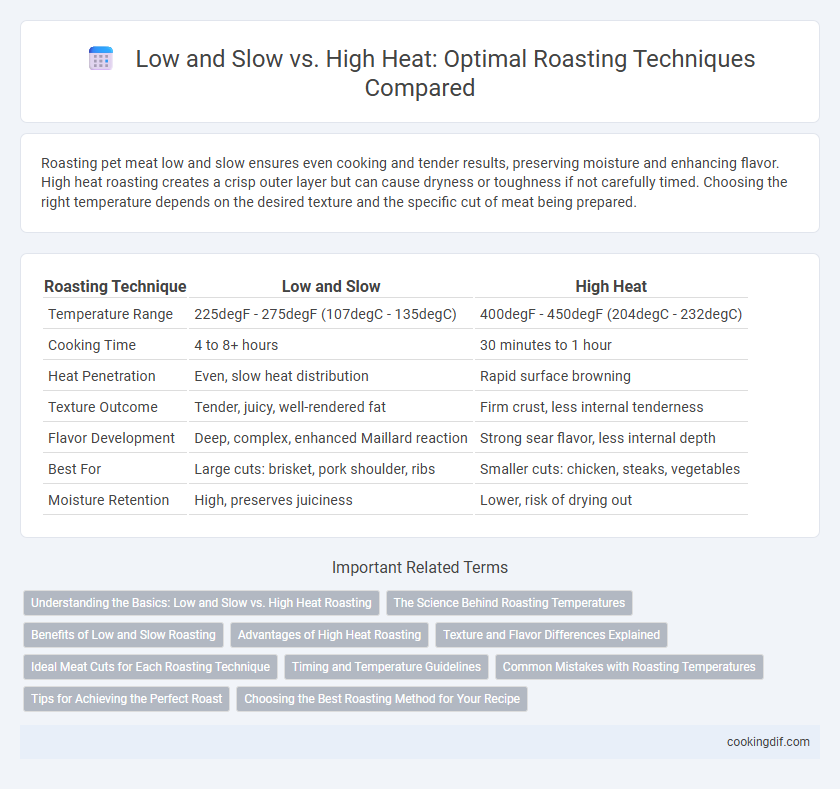Roasting pet meat low and slow ensures even cooking and tender results, preserving moisture and enhancing flavor. High heat roasting creates a crisp outer layer but can cause dryness or toughness if not carefully timed. Choosing the right temperature depends on the desired texture and the specific cut of meat being prepared.
Table of Comparison
| Roasting Technique | Low and Slow | High Heat |
|---|---|---|
| Temperature Range | 225degF - 275degF (107degC - 135degC) | 400degF - 450degF (204degC - 232degC) |
| Cooking Time | 4 to 8+ hours | 30 minutes to 1 hour |
| Heat Penetration | Even, slow heat distribution | Rapid surface browning |
| Texture Outcome | Tender, juicy, well-rendered fat | Firm crust, less internal tenderness |
| Flavor Development | Deep, complex, enhanced Maillard reaction | Strong sear flavor, less internal depth |
| Best For | Large cuts: brisket, pork shoulder, ribs | Smaller cuts: chicken, steaks, vegetables |
| Moisture Retention | High, preserves juiciness | Lower, risk of drying out |
Understanding the Basics: Low and Slow vs. High Heat Roasting
Low and slow roasting involves cooking food at temperatures between 200degF and 300degF, allowing even heat penetration and tender results, particularly for tough cuts like brisket and pork shoulder. High heat roasting, typically above 400degF, rapidly browns the exterior, creating a flavorful crust ideal for vegetables and smaller cuts of meat. Understanding these temperature ranges and their effects on moisture retention and caramelization is key to mastering roasting techniques for optimal texture and flavor.
The Science Behind Roasting Temperatures
Roasting at low and slow temperatures allows heat to penetrate evenly, breaking down collagen in meats and achieving tender, juicy results through gradual Maillard reactions. High heat roasting rapidly develops a flavorful crust via intense surface browning but can risk overcooking the interior if not carefully monitored. Understanding the thermal conductivity and moisture retention of different foods helps optimize roasting temperature to balance texture, flavor, and juiciness.
Benefits of Low and Slow Roasting
Low and slow roasting enhances meat tenderness by breaking down collagen into gelatin, resulting in a juicy, flavorful texture. This method allows for even heat distribution, minimizing moisture loss and preserving natural flavors. Slow roasting also reduces the risk of overcooking, ensuring a consistently succulent and perfectly cooked dish.
Advantages of High Heat Roasting
High heat roasting creates a caramelized, crispy exterior that enhances flavor and texture, making meats and vegetables more appealing. This technique reduces cooking time significantly, preserving moisture and nutrients within the food. High heat also promotes the Maillard reaction, enriching the roast with deep, complex flavors absent in low and slow methods.
Texture and Flavor Differences Explained
Roasting low and slow at temperatures around 225-275degF enhances tenderness by breaking down collagen, resulting in a moist, juicy texture with deep, concentrated flavors. High-heat roasting, typically above 400degF, creates a crispy, caramelized crust through the Maillard reaction, intensifying savory notes and providing a contrasting texture. The choice between these methods significantly affects the final dish's flavor profile and mouthfeel, with low and slow favoring rich, melt-in-the-mouth qualities, while high heat produces a robust, crispy exterior.
Ideal Meat Cuts for Each Roasting Technique
Low and slow roasting is ideal for tougher cuts like brisket, pork shoulder, and lamb shank, allowing collagen to break down and result in tender, flavorful meat. High heat roasting suits tender cuts such as ribeye, prime rib, and tenderloin, quickly searing the exterior while preserving juiciness inside. Choosing the right roasting technique based on meat cut enhances texture and maximizes flavor development.
Timing and Temperature Guidelines
Low and slow roasting at temperatures between 225degF and 275degF ensures even heat penetration and tender results, especially for tougher cuts requiring 3 to 6 hours or more. High-heat roasting, typically at 400degF to 450degF, cooks meat quickly in 20 to 40 minutes but risks uneven cooking and dryness if not monitored closely. Optimal timing balances desired internal temperature--such as 135degF for medium-rare beef--with the appropriate heat level to maximize juiciness and texture.
Common Mistakes with Roasting Temperatures
Common mistakes in roasting temperatures include using high heat for thick cuts, which leads to burned exteriors and undercooked interiors, or opting for low and slow heat without sufficient time, resulting in tough and dry meat. Proper temperature control is essential to achieve even cooking and desired texture, especially when roasting large cuts like prime rib or pork shoulder. Neglecting to preheat the oven can also cause temperature fluctuations that compromise the quality of the roast.
Tips for Achieving the Perfect Roast
Low and slow roasting at temperatures between 225degF to 300degF allows even cooking and tenderizes tougher cuts by breaking down connective tissues. High heat roasting, typically above 400degF, creates a flavorful crust through Maillard reaction but requires careful monitoring to prevent burning. For the perfect roast, preload the oven for consistent heat, use a meat thermometer to track internal temperature, and allow resting time to redistribute juices.
Choosing the Best Roasting Method for Your Recipe
Selecting the optimal roasting method depends on the type and thickness of the meat, with low and slow roasting ideal for tougher cuts like brisket or pork shoulder to achieve tender, juicy results through gradual collagen breakdown. High heat roasting suits tender cuts such as chicken breasts or steaks, creating a flavorful crust via Maillard reaction while preserving internal moisture by shortening cooking time. Temperature control and timing are crucial factors in maximizing flavor and texture, ensuring perfect doneness based on the specific protein and desired outcome.
Low and slow vs high heat for roasting technique Infographic

 cookingdif.com
cookingdif.com